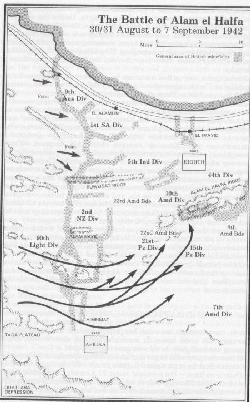
- 30th August to September 7th 1942.

- 30th August to September 7th 1942.
 ,
,  From Montgomery`s Point Of View
From Montgomery`s Point Of View
At Alam Halfa Montgomery`s first battle in North Africa, his military doctrine was to be put to the test. Rommel attacked and informed by ULTRA Montgomery was able to deduce that the attack would come from the South and an outflanking manouvre would be attempted. By carefully positioning his forces, digging in his tanks and instructing his troops as to what the battle plan was, Montgomery and the Eighth Army took on the full might of the Afrika Corps.
The Eighth Army held the all important Alam El Halfa and Ruweisat Ridges and knowing what Rommel was intending to do, it wore down his armour and forced him to retreat. Alam Halfa was from the British point of view, one of the best examples of Army-Air cooperation in the Western Desert 1 RAF and the flanking attacks from the 7th Armoured Division, which further weakened the backbone of his Afrika Corps. The Battle at Alam Halfa was won by the Eighth Army who enjoyed Air superiority and the benefit of knowing what the enemy was about to do.
 From Rommels Point Of View
From Rommels Point Of View
For the 'Desert Fox' the battle at Alam Halfa was the last bid to defeat the Eighth Army and seize Egypt. Rommel was forced to attack as he knew his numerical superiority was dwindling away and would soon be outnumbered by the Allies. Rommel was facing an army that was in a very good defensive position, occupying the high ridges and with one flank covered by the sea and decided to try what seemed to me, the same manouvre as he did at Gazala
High Command Disputes And Interference
Concluding thoughts on the North African Campaign